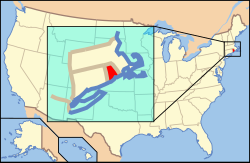
The following outline is provided as an overview and topical guide to the U.S. State of Rhode Island:
Contents
- General reference
- Geography of Rhode Island
- Places in Rhode Island
- Environment of Rhode Island
- Regions of Rhode Island
- Demography of Rhode Island
- Government and politics of Rhode Island
- Branches of the government of Rhode Island
- Law and order in Rhode Island
- Military in Rhode Island
- Local government in Rhode Island
- History of Rhode Island
- History of Rhode Island, by period
- History of Rhode Island, by region
- History of Rhode Island, by subject
- Culture of Rhode Island
- The arts in Rhode Island
- Sports in Rhode Island
- Economy and infrastructure of Rhode Island
- Education in Rhode Island
- See also
- References
- External links


